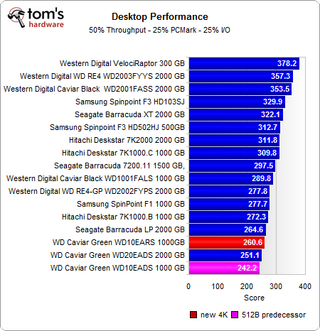HDDs, The Next Generation: Drives With 4KB Sectors On The Way
Conclusion

The idea of increasing sector sizes isn’t new. We've been discussing such advances for more than a decade, so we hesitate to call it "advanced." Although there are no noticeable benefits for customers today in moving to 4K sectors, the step is an important one. Modern operating systems, such as Windows Vista or Windows 7, can handle different sector sizes and hence are immediately compatible with the modified technology without any performance impact. Older operating systems, such as Windows XP, can be forced to align their 512 byte sectors into the hard drives’ physical ones via tools that relocate partitions to have them start at a suitable sector. This is important to do if you don’t want massive performance impacts on your writes.
Systems will not change to a sector size larger than 512 bytes anytime soon for compatibility reasons. Still, hard drive makers benefit from the increased physical sector rearrangement. The storage requirements for ECC data decrease noticeably and there is less capacity overhead due to the inter-sector margins necessary to differentiate sectors from one another. In effect, WD and other hard drive makers following the path to 4KB sectors will receive a 10% capacity upgrade for free. We may not immediately see hard drives hitting shelves with 10% more capacity, but the next capacity steps could be reached a bit quicker.
The new WD10EARS drive delivers higher performance than its predecessor, the WD10EADS, at similar power consumption and slightly increased efficiency. Although the drive doesn’t perform well enough to be a suitable system drive for performance desktops, it delivers more than enough performance for storage and archiving applications or low-power HTPC systems.
Stay on the Cutting Edge
Join the experts who read Tom's Hardware for the inside track on enthusiast PC tech news — and have for over 25 years. We'll send breaking news and in-depth reviews of CPUs, GPUs, AI, maker hardware and more straight to your inbox.
Most Popular

